#Pyhton
Explore tagged Tumblr posts
Text
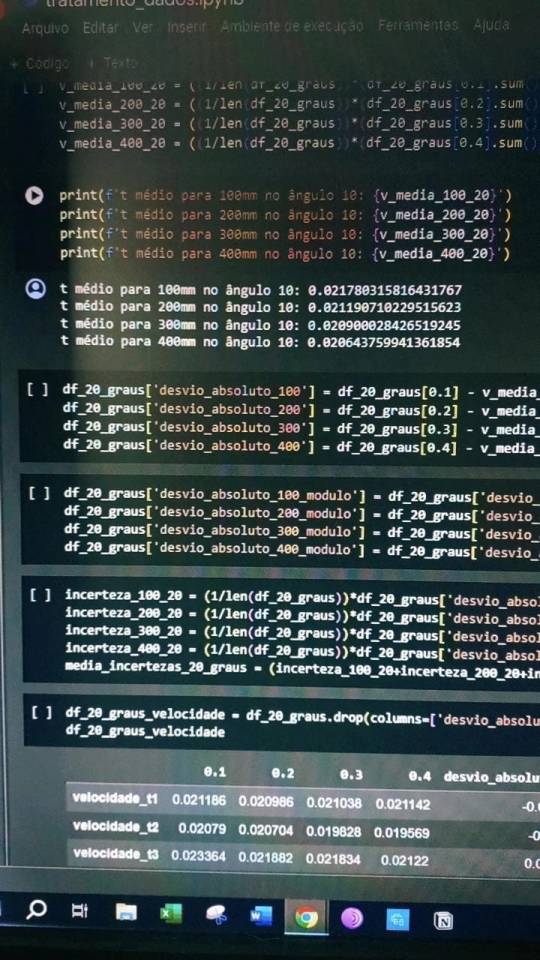

─── ・ 。゚☆: *.☽ .* :☆゚. ────── ・ 。゚☆: *.☽ .* :☆゚. ────── ・ 。゚☆:

𝓜𝓪𝓻𝓬𝓱 11𝓽𝓱, 2024

I had a busy day today, I had to code for some hours and wrote my physics report, It's almost done and I need to deliver it tomorrow. I studied Russian, studied a bit of physics concepts and I'm working on my portfolio to show my codes and the projects I've done.

#stem#studyblr#studyspo#stem academia#study motivation#studying#studyinspo#study aesthetic#calculus#engineering#student life#student#stemblr#university#college#computer engineering#coding#programming#pyhton
26 notes
·
View notes
Text
Exercise to do with python :

Write a Python program to print "Hello, World!"
This is a basic Python program that uses the print statement to display the text "Hello, World!" on the console.
Write a Python program to find the sum of two numbers.
This program takes two numbers as input from the user, adds them together, and then prints the result.
Write a Python function to check if a number is even or odd.
This exercise requires you to define a function that takes a number as input and returns a message indicating whether it is even or odd.
Write a Python program to convert Celsius to Fahrenheit.
This program prompts the user to enter a temperature in Celsius and then converts it to Fahrenheit using the conversion formula.
Write a Python function to check if a given year is a leap year.
In this exercise, you'll define a function that checks if a year is a leap year or not, based on leap year rules.
Write a Python function to calculate the factorial of a number.
You'll create a function that calculates the factorial of a given non-negative integer using recursion.
Write a Python program to check if a given string is a palindrome.
This program checks whether a given string is the same when read backward and forward, ignoring spaces and capitalization.
Write a Python program to find the largest element in a list.
The program takes a list of numbers as input and finds the largest element in the list.
Write a Python program to calculate the area of a circle.
This program takes the radius of a circle as input and calculates its area using the formula: area = π * radius^2.
Write a Python function to check if a string is an anagram of another string.
This exercise involves writing a function that checks if two given strings are anagrams of each other.
Write a Python program to sort a list of strings in alphabetical order.
The program takes a list of strings as input and sorts it in alphabetical order.
Write a Python function to find the second largest element in a list.
In this exercise, you'll create a function that finds the second largest element in a list of numbers.
Write a Python program to remove duplicate elements from a list.
This program takes a list as input and removes any duplicate elements from it.
Write a Python function to reverse a list.
You'll define a function that takes a list as input and returns the reversed version of the list.
Write a Python program to check if a given number is a prime number.
The program checks if a given positive integer is a prime number (greater than 1 and divisible only by 1 and itself).
Write a Python function to calculate the nth Fibonacci number.
In this exercise, you'll create a function that returns the nth Fibonacci number using recursion.
Write a Python program to find the length of the longest word in a sentence.
The program takes a sentence as input and finds the length of the longest word in it.
Write a Python function to check if a given string is a pangram.
This function checks if a given string contains all the letters of the alphabet at least once.
Write a Python program to find the intersection of two lists.
The program takes two lists as input and finds their intersection, i.e., the common elements between the two lists.
Write a Python function to calculate the power of a number using recursion.
This function calculates the power of a given number with a specified exponent using recursion.
Write a Python program to find the sum of the digits of a given number.
The program takes an integer as input and finds the sum of its digits.
Write a Python function to find the median of a list of numbers.
In this exercise, you'll create a function that finds the median (middle value) of a list of numbers.
Write a Python program to find the factors of a given number.
The program takes a positive integer as input and finds all its factors.
Write a Python function to check if a number is a perfect square.
You'll define a function that checks whether a given number is a perfect square (i.e., the square root is an integer).
Write a Python program to check if a number is a perfect number.
The program checks whether a given number is a perfect number (the sum of its proper divisors equals the number itself).
Write a Python function to count the number of vowels in a given string.
In this exercise, you'll create a function that counts the number of vowels in a given string.
Write a Python program to find the sum of all the multiples of 3 and 5 below 1000.
The program calculates the sum of all multiples of 3 and 5 that are less than 1000.
Write a Python function to calculate the area of a triangle given its base and height.
This function calculates the area of a triangle using the formula: area = 0.5 * base * height.
Write a Python program to check if a given string is a valid palindrome ignoring spaces and punctuation.
The program checks if a given string is a palindrome after removing spaces and punctuation.
Write a Python program to find the common elements between two lists.
The program takes two lists as input and finds the elements that appear in both lists.
15 notes
·
View notes
Text
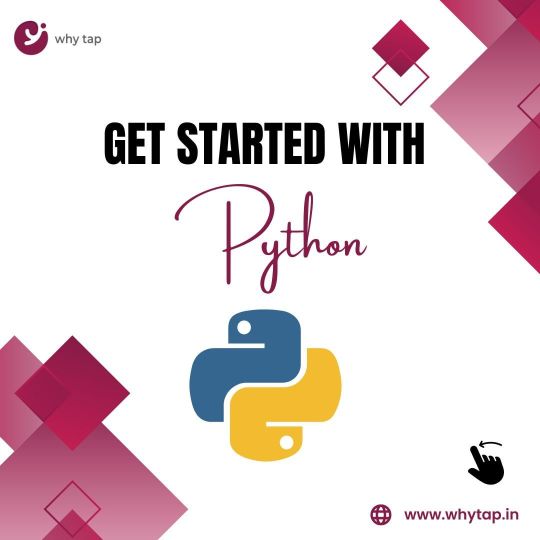


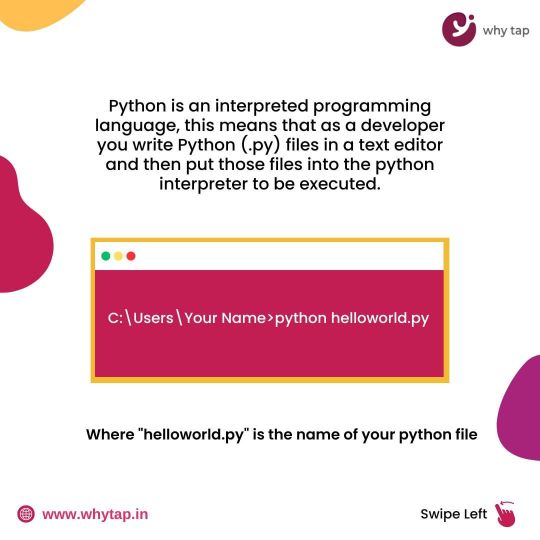

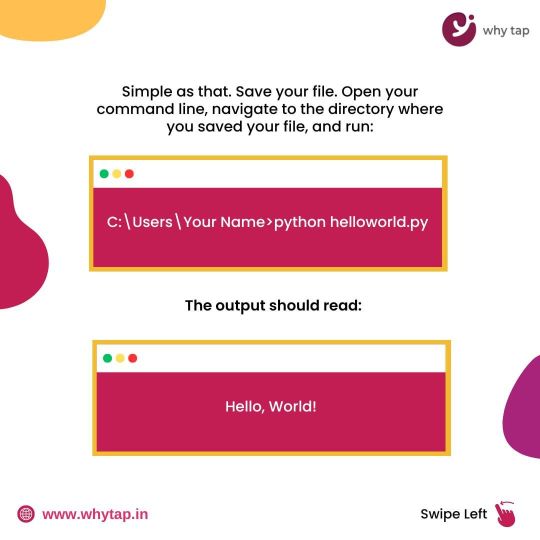
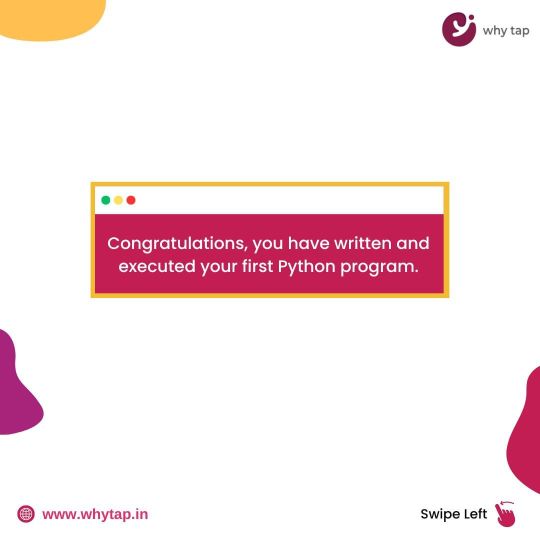

WHY tap
#placement#training#pyhton#python developers#python certification#programming#coding#angularjs#python#learn python
6 notes
·
View notes
Text

WHAT IS PYTHON? Python is a high-level, interpreted programming language known for its readability and simplicity. It was created by Guido van Rossum and first released in 1991. Here are some key features and the need for Python
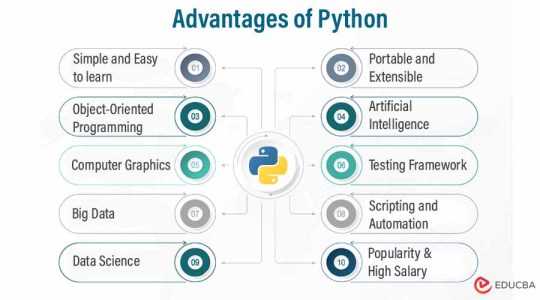
Data Science and Machine Learning: Python is widely used in data analysis, machine learning, and artificial intelligence due to its powerful libraries like TensorFlow, Scikit-learn, and Matplotlib. Web Development: Frameworks like Django and Flask make it easy to build robust web applications quickly. Automation and Scripting: Python is often used for automating repetitive tasks, making it a valuable tool for system administrators and developers. Education: Its simplicity makes Python an excellent choice for teaching programming concepts to beginners. Rapid Prototyping: Python allows developers to quickly build and test prototypes, enabling faster development cycles.
1 note
·
View note
Text
My body is a machine that turns footlong subway sandwiches into awful python code
#grad student#grad school#graduate school#graduate student#chemistry#data analysis#pyhton#computer science#academia
1 note
·
View note
Text
The Power of Python | A Beginner's Guide to Python Programming
The Power of Python | A Beginner's Guide to Python Programming
1 note
·
View note
Text
Building Predictive Models with Python: Hands-on Tutorial
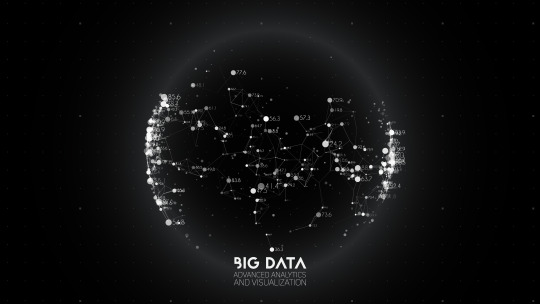
Building predictive models with Python empowers data scientists to extract valuable insights from data and make informed decisions. In this hands-on tutorial, we'll delve into the fundamental steps of constructing predictive models.
We start by importing essential libraries such as NumPy, Pandas, and Scikit-Learn, creating a robust foundation. Exploratory Data Analysis (EDA) follows, where we visualize and understand the dataset's characteristics.
Preprocessing steps involve handling missing data, encoding categorical variables, and scaling features for optimal model performance. The tutorial guides you through splitting the dataset into training and testing sets to evaluate model generalization.
We explore various algorithms, from simple linear regression to complex ensemble methods like Random Forests. Understanding model evaluation metrics such as accuracy, precision, and recall ensures a comprehensive assessment of predictive performance.
The tutorial also addresses hyperparameter tuning to optimize model parameters and enhance predictive accuracy. Visualization techniques, like ROC curves, aid in assessing model robustness.
Throughout the tutorial, practical examples and code snippets illustrate each concept, enabling hands-on learning. By the end, participants will have a solid foundation in building predictive models using Python, a valuable skill applicable across industries for solving real-world problems.
Data science training in bangalore
0 notes
Text
Python Unleashed: Revolutionizing Industries Across the Tech Spectrum
Python, an influential force in the programming world, is not just a language; it's a versatile solution that transcends industries, leaving an indelible mark on technology landscapes globally. Let's traverse the vast landscape of Python applications, exploring how this programming language has evolved into a catalyst for innovation across diverse sectors.
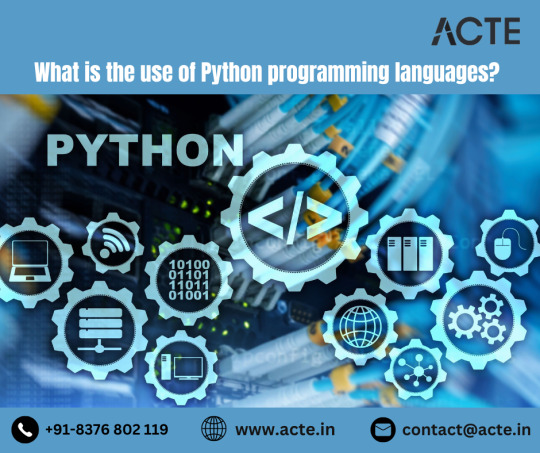
1. Crafting Dynamic Web Experiences:
Python stands tall in the realm of web development, boasting frameworks like Django and Flask. These frameworks empower developers to architect dynamic and scalable web applications effortlessly. Python's clean syntax and robust frameworks contribute to a seamless development experience, solidifying its place as a preferred choice for web development.
2. Data Alchemy and Machine Learning Mastery:
Python reigns supreme in the realms of data science and machine learning, offering a rich toolkit with libraries such as NumPy, Pandas, and Scikit-Learn. Its readability becomes a powerful asset in collaborative data science projects, fostering effective communication among team members. Python emerges as the linchpin for unraveling insights from complex datasets and crafting intelligent machine learning models.
3. The Scripting Virtuoso:
Python's simplicity and readability make it an unparalleled choice for automation and scripting. From simplifying file operations to automating data parsing and system interactions, Python scripts emerge as elegant solutions for streamlining intricate workflows. Python's versatility shines as it navigates through repetitive tasks with ease.
4. AI Prowess and Linguistic Wizardry:
Python's prowess extends into the realm of artificial intelligence (AI) development, backed by robust libraries like TensorFlow and PyTorch. Simultaneously, Python finds itself at the forefront of natural language processing (NLP) applications, contributing to the creation of intelligent systems capable of comprehending and processing human language.
5. Game Development Unleashed:
Python's synergy with the Pygame library propels it into the spotlight of the game development community. The combination offers a user-friendly environment for game developers, lowering entry barriers and allowing the creation of both simple games and sophisticated prototypes. Python's approachability becomes a game-changer in the realm of game development.

6. Networking Maestro:
Python's simplicity and comprehensive library support position it as a stalwart in network server creation and networking tools development. Whether it's network programming or crafting applications for intricate network-related tasks, Python's versatility stands out, providing a reliable foundation for developers.
7. Scientific Frontiers Explored:
Scientific computing embraces Python with open arms. Libraries like SciPy and Matplotlib enhance Python's suitability for scientific applications, facilitating simulations and numerical computations. The scientific community's widespread adoption of Python underscores its flexibility and seamless integration capabilities.
8. Cybersecurity Guardian:
Python emerges as a cybersecurity ally, driven by its user-friendly design and adaptability. Its significance in penetration testing, network scanning, and security tool development highlights Python's role in fortifying cybersecurity measures. The language's versatility becomes a cornerstone in ensuring robust defenses against cyber threats.
9. Nurturing Tech Prodigies:
Python's readability and simplicity make it an educational beacon, guiding the programming journeys of students worldwide. As an introductory language, Python provides a gentle learning curve, laying a foundation for the future generation of programmers. Its widespread adoption in educational institutions marks Python as a catalyst for fostering technological literacy.
10. Crafting Desktop Dreams:
Equipped with libraries like Tkinter and PyQt, Python extends its reach into desktop application development. Developers harness Python's capabilities to create intuitive and interactive Graphical User Interface (GUI) applications, expanding its influence into the realm of desktop software development.
In summation, Python's influence transcends boundaries, from web development to AI, game development, and cybersecurity. Its role as a catalyst for innovation is underscored by an ecosystem of libraries and frameworks that empower developers to usher in efficiency, readability, and unparalleled versatility across diverse projects.
0 notes
Video
youtube
Remove all special characters, punctuation except spaces from string - P...
0 notes
Text
https://www.apponix.com/Python-Institute/Python-Training-in-Bangalore.html
0 notes
Text
Keywords for Python and identifiers
Understanding identifiers is critical while working in Python. Variables, functions, classes, and other elements in a Python programmer are given names called Keywords and Identifiers in Python. They are critical in making code understandable, manageable, and efficient. We will dig into the realm of Python identifiers in this thorough tutorial, covering everything from naming standards to recommended practice's.
0 notes